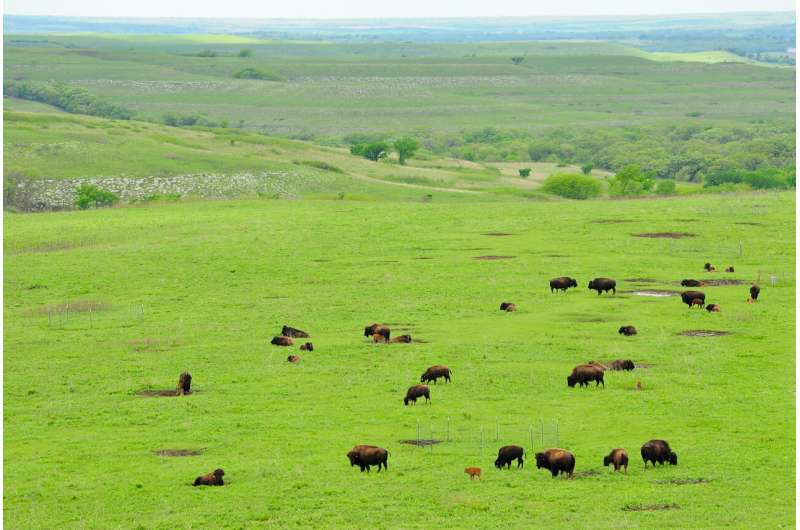Reintroducing bison to grasslands increases plant diversity, drought resilience, study finds

A Kansas State University-led study has found that reintroducing bison—a formerly dominant grazer—doubles plant diversity in a tallgrass prairie. The research involves more than 30 years of data collected at the Konza Prairie Biological Station and was recently published in the prestigious journal Proceedings of the National Academy of Science, or PNAS.
The study found that plant communities also were resilient to the most extreme drought in four decades. These gains are now among the largest recorded increases in species richness because of grazing in grasslands globally, researchers said.
"Bison were an integral part of North American grasslands before they were abruptly removed from over 99% of the Great Plains," said Zak Ratajczak, assistant professor of biology and lead researcher. "This removal of bison occurred before quantitative records and therefore, the effects of their removal are largely unknown."
The study took place in the Flint Hills ecoregion, which is the largest remaining landscape of tallgrass prairie. Researchers examined plant community composition and diversity in three treatments that were designed to capture characteristic management regimes: no mega-grazers were present; bison were reintroduced and allowed to graze year-round; or domestic cattle were introduced and allowed to graze during the growing season.
"Our results suggest that many grasslands in the central Great Plains have substantially lower plant biodiversity than would have occurred before bison were widely wiped out," Ratajczak said. "Returning or 'rewilding' native megafauna could help to restore grassland biodiversity."
The study also found that cattle had a positive impact on plant diversity, compared to having no large grazers present, although increases in plant species richness were significantly smaller than those caused by bison.
"I think this study also shows that cattle can have a largely positive impact on biodiversity conservation in our region, especially considering that many in cattle production conduct the prescribed fires that have kept these grasslands from becoming woodlands," Ratajczak said. "What this study really suggests is that when it's economically and ecologically feasible, reintroducing bison might have an even more positive effect on biodiversity conservation."
Along with addressing land use, researchers also set out to learn how bison affect plant community resilience to climate extremes. Because of the long duration of the study, researchers were able to capture one of the most extreme drought events that has occurred in the Great Plains since the 1930s' Dust Bowl.
Researchers found that after the climate extreme, native plant species in the bison-grazed area were resilient to drought.
"The resilience we found in the bison grasslands is also consistent with the idea that diversity promotes ecological resilience," Ratajczak said. "And this resilience will only become more important if our climate becomes more extreme."
Other K-State researchers on the study include Jesse Nippert, professor; John Blair, university distinguished professor; Allison Louthan, assistant professor; and Jeffrey Taylor, research assistant, all from the Division of Biology in the College of Arts and Sciences. Additional collaborators include Scott Collins, University of New Mexico; Sally Koerner, University of North Carolina; and Melinda Smith, Colorado State University.
"Some of the most meaningful ecological trends take decades to unfold, and we can only identify them using long-term records like those supported by the NSF LTER program," Nippert said. "Without this type of data, fundamental properties of ecosystems may go unnoticed using only short-term experiments."
"The research done at the Konza Prairie is truly unique and impressive, " said David Rosowsky, K-State vice president for research. "There are very few locations in the world that can provide this type of long-term data that can have such a strong impact on how we interact with our natural resources."
More information: Zak Ratajczak et al, Reintroducing bison results in long-running and resilient increases in grassland diversity, Proceedings of the National Academy of Sciences (2022). DOI: 10.1073/pnas.2210433119
Journal information: Proceedings of the National Academy of Sciences
Provided by Kansas State University




















